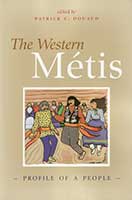by Susan Berry
Royal Alberta Museum, Edmonton
|
Patrick C. Douaud, editor, The Western Métis: Profile of a People Regina: Canadian Plains Research Center, University of Regina, 2007, 326 pages, ISBN 9780889771994, $29.95 (paperback)
 This book brings together thirteen articles on aspects of Métis history that have appeared over the past three decades in Prairie Forum, an interdisciplinary journal published by the Canadian Plains Research Center at the University of Regina. It also features an introductory essay by Prairie Forum’s editor-inchief Patrick Douaud. In keeping with the journal’s mandate to publish articles relevant to the Canadian Plains, The Western Métis: Profile of a People focuses on Métis experiences in the Prairie Provinces. Most of the contributors are professional historians, and all deal with developments taking place in the nineteenth century or earlier.
This book brings together thirteen articles on aspects of Métis history that have appeared over the past three decades in Prairie Forum, an interdisciplinary journal published by the Canadian Plains Research Center at the University of Regina. It also features an introductory essay by Prairie Forum’s editor-inchief Patrick Douaud. In keeping with the journal’s mandate to publish articles relevant to the Canadian Plains, The Western Métis: Profile of a People focuses on Métis experiences in the Prairie Provinces. Most of the contributors are professional historians, and all deal with developments taking place in the nineteenth century or earlier.
Douaud explains that the contributions were chosen for the “breadth and scope of the investigations upon which they are based, and for the reflections they will arouse in anyone interested in Western Canadian history and politics” (p. 17). The book is intended, then, for a general audience. The narrow focus of several articles, however, combined with passages quoting source material in French and German, suggest that most of the authors were writing for an academic audience.
The articles appear to be grouped around four themes—Métis origins, involvement in the fur trade, loss of land following incorporation into the Canadian state, and personalities and events associated with the resistance movements of 1869–1870 and 1885. This organizational scheme is never formally stated, however, and the themes are not immediately apparent. The book would have been easier to navigate had the articles been presented under subheadings identifying major themes. An editorial statement introducing each theme could have provided further coherence as well as insight into how scholarship in the field has taken shape over time.
Some of the book’s strongest material addresses the establishment of western Métis communities in the late 1700s. John Foster’s classic essay, “Wintering, the Outsider Adult Male and the Ethnogenesis of the Western Plains Métis”, outlines the initial steps. They include the practice of “wintering”, in which a fur trader spent the winter hunting with a First Nations band, marriage to a woman of the band, and the decision to become an independent trader. As friendships with other freemen and their families solidified, a distinctive society emerged. This work is nicely complemented by a contribution from Ruth Swan and Edward Jerome that traces how the process Foster described unfolded in the case of one freeman and his descendants.
Manitoba History readers may take special interest in a pair of articles debating the terms under which Métis residents lost land reserved for them under the 1870 Manitoba Act. In “The Market for Métis Lands in Manitoba: An Exploratory Study”, Thomas Flanagan tracks 59 children’s land grant allotments. While he finds that over 90% had been sold by 1890, most at a deep discount, he contends that the Métis received fair compensation in an “open and highly competitive” market (p. 122). D. N. Sprague’s counterargument, “Dispossession vs. Accommodation in Plaintiff vs. Defendant Accounts of Métis Dispersal from Manitoba, 1870–1881”, examines Dominion Lands grants records and personal testimonials. He concludes that legal roadblocks and unreasonable deferrals amounted to a policy of “discouragement by delay and denial” (p. 135) that left most people little choice but to sell to speculators at cut-rate prices.
Other selections are less felicitous. J. M. Bumsted’s charitable re-assessment of Canadian loyalist Thomas Scott (“Thomas Scott and the Daughter of Time”), although a legitimate contribution to western Canadian historiography, seems out of place in a book on Métis history. Manfredd Mossmann’s psychocultural take on the 1885 Riel Resistance (“The Charismatic Pattern: Canada’s Riel Rebellion of 1885 as a Millenarian Protest Movement”) sheds little light on the circumstances that led the Saskatchewan Métis to take up arms. And his characterization of the Métis as “willing to fight and die for their Lebensraum” (p. 188) is culturally inappropriate. Douaud likewise strikes a discordant note with his introductory essay, “Genesis.” His emphasis on the biological component of ethnic identity is at odds with the culturally-based analyses of other contributors, while his use of terms such as “interbreeding” and “miscegenation” will offend many readers.
In sum, while The Western Métis has strengths, it also has deficiencies. The failure to address Métis history post-1885 is particularly disappointing. Prairie Forum has published articles on contemporary Métis experiences—see, for example, Barsh et al. 2000 and Belisle 2006. Including either would have made the point that the Métis remain a vital part of Canadian society and helped round out this “profile of a people”.
Métis Red River carts from Pembina encamped on St. Anthony Hill, 1858.
Source: Archives of Manitoba, Transportation-Red River Cart 45.
Barsh, Russel Lawrence, E. Ann Gibbs and Tara Turner, “The Métis of Lethbridge: A Microcosm of Identity Politics,” Prairie Forum, Vol. 25, No. 2 (Fall 2000): pp. 283-295.
Belisle, Darcy, “Finding Home on the Way: Naming the Métis,” Prairie Forum, Vol. 31, No. 1 (Spring 2006): pp. 105-120.
Page revised: 14 June 2014